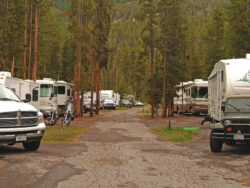Roads in Yellowstone Park are narrow and follow steep and windy contours. Many of the roads are the same as they were when I was kid in the 1960’s. They may have a new turn lane or have had resurfacing, but the width and path of the roadways are the same.
Campgrounds were also created and developed decades ago. Back in the day campers still used tents and smaller rigs and RVs. Our Yellowstone camper was a 14-foot Winnebago that we used to camp in the park all summer long. We moved every 2 weeks to explore and discover new areas. Years later the pull through campsites were perfect for a car and a tent. Smaller trucks, cars, and tow rigs were able to easily navigate the narrow and minimal pathways through the park. 
Today, the Park invites gigantic crowds, RVs, and busloads of visitors. Trailers longer than 20 feet in length, along with motorhomes towing cars, barely squeeze into campsites and along the roads. Buses with dozens of tourists bounce along the curves leaving little space for oncoming traffic to squeeze by.
When sleighs and small buses were the first mass transit forms of transportation in the park, folks stayed out of the park and traveled in for the day. The perimeter towns and access locations had a bountiful business where people could visit the park and then leave. Even a train ventured into West Yellowstone to drop off visitors, then take them back to Three Forks or Whitehall.
We need to rethink how we enjoy our parks. Recent trends in visitation have impacted the Park experience in a negative way. It is time for motorhomes to camp outside the park and use their tow rigs to tour. Campgrounds need to downsize to smaller units under 20 feet long. Generators need to get turned off and campers need to be able to camp again. Busloads of tourists are big money. Flag waving tour groups flood the walkways and hog the roads. Perhaps smaller buses of 20 guests is a better way to go.
Yellowstone and so many of our parks are amazing because of their rural and less crowded open spaces, enhanced with geothermal, waterfalls, glaciers, trails, geology, and wildlife. Ecosystems have what is called a Carrying Capacity. This is the number of plants, critters, and human pressure than can be applied while still maintaining a healthy ecosystem.
Yellowstone and other Parks are exceeding capacity. The result is a less quality experience for everyone. More stress on the wildlife, more pollution, and more accidents. Locals often get left out due to the immense crowds. Many of us live near these places to enjoy the Big Sky lifestyle but get pushed aside by the army of tourists.
Traffic jams, litter, overworn pathways, lack of parking, crowded campgrounds, and limited facilities make for a less favorable Park experience. Fisheries get pounded and finding a place to simply watch Old Faithful become harder.
Hopefully, tourists and park officials will help develop some new Road Rules to make the Parks even better.
Montana Grant